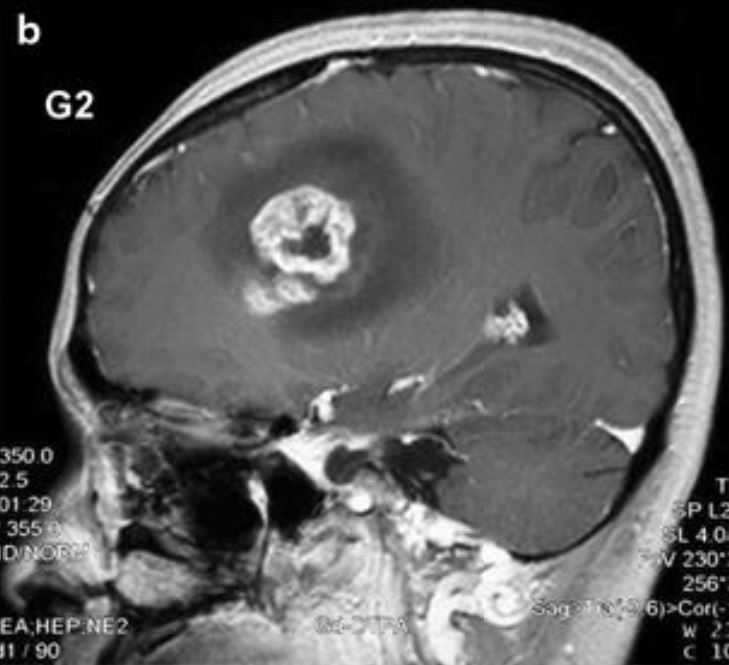Playlist
Show Playlist
Hide Playlist
Glioma: Introduction and Clinical Presentation
-
Strowd CNS Tumors Glioma.pdf
-
Download Lecture Overview
00:01 So let's learn a little bit more about glioma. 00:03 How do we diagnose? How do we treat and manage these patients? And we're going to talk about this through the time course of a patient. 00:11 We're going to start with symptom onset, understand the clinical presentation and evaluation, and then talk about treatment over time. 00:20 So let's start with presentation. 00:22 How do patients present? Well, it's all about location. 00:27 And the location of the tumor determines the type of presentation. 00:32 It's not uncommon for patients to present with headache, or cognitive changes. 00:36 We can also see seizures. 00:38 But there's a lot of other symptoms that can be present in patients who have a new glioma. 00:43 Headache, memory loss, cognitive changes, motor, sensory, language deficits, visual problems, personality changes, nausea/vomiting from increased intracranial pressure, and even papilledema from a fast growing tumor that's increasing intracranial pressure. 00:57 If you look at the percentages how common each of these symptoms are, most symptoms are present in at least 25% of patient, but none of them reach 50% of patients. 01:08 And this is because the location of these tumors are highly variable. 01:11 And symptoms are determined by the location of the tumor. 01:15 We do tend to see two types of presentations and one is focal neurologic deficits of any kind. 01:21 And you can see those in the table here, and the other is seizure. 01:24 And that information can help us in understanding maybe what type of tumor or glioma we're dealing with. 01:31 Let's think more specifically about seizures. 01:34 Seizures present in about 40% of glioma patients. 01:38 Epilepsy has a certain prognostic value and so low grade tumors that are more slowly growing are less likely to cause a focal neurologic deficit. 01:48 because they grow slowly, the brain is able to accommodate that tumor, and we often see seizures. 01:55 High grade tumors grow more rapidly. 01:57 The brain cannot accommodate that rapid growth and we see focal neurologic deficits and increased ICP, and seizures occur less frequently. 02:06 As a result, epilepsy or the presence of epilepsy is favorable prognostic factor for high grade gliomas, and a less favorable prognostic factor, or not a prognostic factor, for patients with low grade gliomas. 02:19 Seizures are also important in patients who are known to have a tumor and may present later in their course with a new onset seizure. 02:27 And it turns out about half of the time that patients present with a breakthrough seizure, it indicates tumor growth. 02:33 And about half the time a new breakthrough seizure does not indicate new tumor growth. 02:38 That seizure is really indicative of cortical irritability, not necessarily the growth pattern of the tumor. 02:46 How common is epilepsy in certain types of gliomas? Well, we're going to talk a little bit more about the grades of these tumors, but the high grade tumors like glioblastoma, the prevalence of epilepsy is lower 30 to 50%. 02:58 And the low grade tumors the grade II tumors, we see a much higher prevalence of epilepsy around 70 to 85%. 03:06 What are the risk factors for developing gliomas? Well, they just happen. 03:11 There's not a lot of reasons why patients develop these tumors, things that they do to cause them, or things that they didn't do that could have prevented them. 03:19 There are a few things that I'd like for you to know about. 03:22 First is ionizing radiation. 03:24 This increases the risk of any tumor. 03:26 Gliomas in the brain, meningiomas in the meninges and sarcomas in the soft tissue. 03:31 And so patients who have had therapeutic radiation are at higher risk for gliomas. 03:37 We don't see an increased risk of brain tumors with cell phones. 03:40 That's an important thing, because that does come up out there in the world. 03:44 Head trauma doesn't clearly increase the risk of developing a brain tumor. 03:48 Though we do imaging more in those patients and sometimes catch those things. 03:52 And there's not a dietary substance that's been shown to cause brain tumors, or prevent them from developing. 03:59 When we think about meningiomas, we also talked about ionizing radiation, and radiation therapy to the brain or meninges can increase the risk of developing both types of tumors, gliomas and meningiomas, and that's an important fact to keep in mind.
About the Lecture
The lecture Glioma: Introduction and Clinical Presentation by Roy Strowd, MD is from the course CNS Tumors.
Included Quiz Questions
A patient with a glioma would most likely present with ...
- ... a headache.
- ... visual disturbance.
- ... nausea and vomiting.
- ... sensory deficits.
- ... papilledema.
Which of the following is a favorable prognostic indicator in high-grade gliomas?
- Epilepsy
- Memory loss
- Language deficits
- Motor deficits
- Sensory deficits
Which of the following is not a risk factor for gliomas?
- Cell phone use
- Turcot syndrome
- Ionizing radiation
- Li-Fraumeni syndrome
- Exposure to vinyl chloride
Customer reviews
5,0 of 5 stars
| 5 Stars |
|
5 |
| 4 Stars |
|
0 |
| 3 Stars |
|
0 |
| 2 Stars |
|
0 |
| 1 Star |
|
0 |





